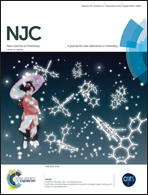Synthesis of silsesquioxane urethane hybrid materials by a modified sol–gel process†
Abstract
Methacrylate silsesquioxane terminated by urethane acrylate (MASSQ-UA) was prepared via a combination of a sol–gel process and urethane chemistry. The organic and inorganic segments were hybridized at the molecular level. The methacrylate silsesquioxane (MASSQ) was first prepared by hydrolysis and condensation reactions. The molar ratio of water to silane was specifically quantified to control the molecular structure, molecular weight and the distribution of MASSQ. MASSQ-UA was then synthesized by terminating the residual silanol groups in the incomplete MASSQ with pre-prepared mono-adducts of isophorone diisocyanate and 2-hydroxylethyl acrylate. In the second step of the reaction, the residual, but still active, silanol groups were effectively reduced and sterically hindered, overcoming the instability problems that frequently occur in traditional sol–gel-derived silsesquioxane. In addition to the methacrylate groups, isophorone diisocyanate and 2-hydroxylethyl acrylate were hybridized with MASSQ. Unlike traditional heterogeneous filler systems, these hybrids are molecular systems and are homogeneous, optically clear fluids in which the inorganic and organic components are linked by covalent bonds. The molecular structures, molecular weight and polydispersity of the final products were investigated by various methods, including matrix-assisted laser desorption/ionization time-of-flight mass spectrometry and electrospray ionization time-of-flight mass spectrometry. The thermal stability of MASSQ-UA and the water resistance of UV-cured MASSQ-UA-based coatings were improved compared with the MASSQ and UV-cured MASSQ-based coatings. The process developed here can be monitored and controlled and could therefore be used industrially for commercial large-scale production.


 Please wait while we load your content...
Please wait while we load your content...